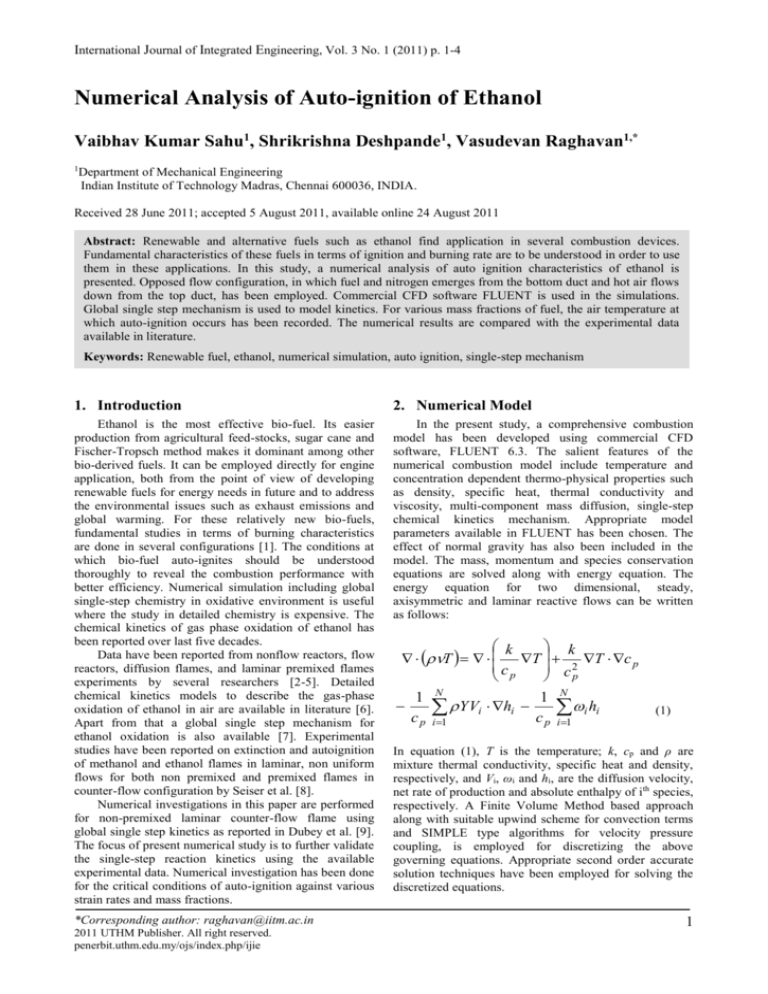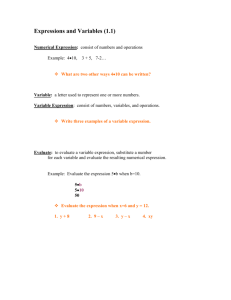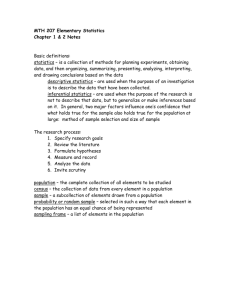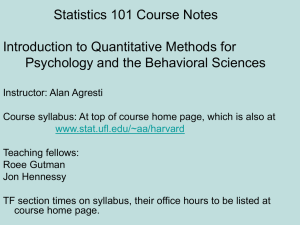
International Journal of Integrated Engineering, Vol. 3 No. 1 (2011) p. 1-4
Numerical Analysis of Auto-ignition of Ethanol
Vaibhav Kumar Sahu1, Shrikrishna Deshpande1, Vasudevan Raghavan1,*
1
Department of Mechanical Engineering
Indian Institute of Technology Madras, Chennai 600036, INDIA.
Received 28 June 2011; accepted 5 August 2011, available online 24 August 2011
Abstract: Renewable and alternative fuels such as ethanol find application in several combustion devices.
Fundamental characteristics of these fuels in terms of ignition and burning rate are to be understood in order to use
them in these applications. In this study, a numerical analysis of auto ignition characteristics of ethanol is
presented. Opposed flow configuration, in which fuel and nitrogen emerges from the bottom duct and hot air flows
down from the top duct, has been employed. Commercial CFD software FLUENT is used in the simulations.
Global single step mechanism is used to model kinetics. For various mass fractions of fuel, the air temperature at
which auto-ignition occurs has been recorded. The numerical results are compared with the experimental data
available in literature.
Keywords: Renewable fuel, ethanol, numerical simulation, auto ignition, single-step mechanism
1. Introduction
2. Numerical Model
Ethanol is the most effective bio-fuel. Its easier
production from agricultural feed-stocks, sugar cane and
Fischer-Tropsch method makes it dominant among other
bio-derived fuels. It can be employed directly for engine
application, both from the point of view of developing
renewable fuels for energy needs in future and to address
the environmental issues such as exhaust emissions and
global warming. For these relatively new bio-fuels,
fundamental studies in terms of burning characteristics
are done in several configurations [1]. The conditions at
which bio-fuel auto-ignites should be understood
thoroughly to reveal the combustion performance with
better efficiency. Numerical simulation including global
single-step chemistry in oxidative environment is useful
where the study in detailed chemistry is expensive. The
chemical kinetics of gas phase oxidation of ethanol has
been reported over last five decades.
Data have been reported from nonflow reactors, flow
reactors, diffusion flames, and laminar premixed flames
experiments by several researchers [2-5]. Detailed
chemical kinetics models to describe the gas-phase
oxidation of ethanol in air are available in literature [6].
Apart from that a global single step mechanism for
ethanol oxidation is also available [7]. Experimental
studies have been reported on extinction and autoignition
of methanol and ethanol flames in laminar, non uniform
flows for both non premixed and premixed flames in
counter-flow configuration by Seiser et al. [8].
Numerical investigations in this paper are performed
for non-premixed laminar counter-flow flame using
global single step kinetics as reported in Dubey et al. [9].
The focus of present numerical study is to further validate
the single-step reaction kinetics using the available
experimental data. Numerical investigation has been done
for the critical conditions of auto-ignition against various
strain rates and mass fractions.
In the present study, a comprehensive combustion
model has been developed using commercial CFD
software, FLUENT 6.3. The salient features of the
numerical combustion model include temperature and
concentration dependent thermo-physical properties such
as density, specific heat, thermal conductivity and
viscosity, multi-component mass diffusion, single-step
chemical kinetics mechanism. Appropriate model
parameters available in FLUENT has been chosen. The
effect of normal gravity has also been included in the
model. The mass, momentum and species conservation
equations are solved along with energy equation. The
energy equation for two dimensional, steady,
axisymmetric and laminar reactive flows can be written
as follows:
*Corresponding author: raghavan@iitm.ac.in
2011 UTHM Publisher. All right reserved.
penerbit.uthm.edu.my/ojs/index.php/ijie
k
k
T T 2 T c p
cp
c
p
1 N
1 N
Y
V
h
i i c i hi
c p i 1
p i 1
(1)
In equation (1), T is the temperature; k, cp and ρ are
mixture thermal conductivity, specific heat and density,
respectively, and Vi, ωi and hi, are the diffusion velocity,
net rate of production and absolute enthalpy of ith species,
respectively. A Finite Volume Method based approach
along with suitable upwind scheme for convection terms
and SIMPLE type algorithms for velocity pressure
coupling, is employed for discretizing the above
governing equations. Appropriate second order accurate
solution techniques have been employed for solving the
discretized equations.
1
V.K. Sahu et al., Int. J. Of Integrated Engineering Vol. 3 No. 1 (2011) p. 1-4
2.1 Numerical Domain
In the axisymmetric model, the computational
domain is as shown in Fig. 1. A domain with extents of
12 mm in the axial direction and 25 mm in the radial
direction is chosen. A commercially available meshing
software called GAMBIT 2.0 has been employed to
create the computational domain and for generating grid.
2.2 Boundary conditions
i. Fuel Inlet: At the fuel inlet boundary, velocity profile
of the fuel jet is specified. Fully developed velocity
profile is prescribed such that the flow rate
corresponding to the experimental value is obtained.
This velocity is calculated for corresponding strain
rate. A constant temperature of 298 K is prescribed.
Mass fraction value of fuel is prescribed
corresponding to the experimental conditions.
ii. Oxidizer Inlet: This boundary is treated in the same
manner as that of fuel inlet boundary. The mass
fraction of oxygen is 0.232. Velocity profile
corresponding to that of oxidizer flow rate has been
specified. Oxidizer velocity is also calculated for
corresponding strain rate. Temperature of oxidizer
has been increased from 298 K to critical
temperature of autoignition.
iii. Pressure Outlet: At the exit boundary, flow leaves to
the atmosphere. Due to buoyancy driven flow,
incoming flow can also occur at this boundary at a
few cells. Therefore, a pressure outlet condition,
which drives the flow with respect to local pressure
gradient, has been chosen at this boundary. In case of
back-flow into the domain oxygen mass fraction of
0.232 and a constant temperature of 300 K are
specified, representing the ambient air.
iv. Axis: This boundary represents the centerline of the
burner. For this axisymmetric problem, an axis
boundary condition has been specified (Fig. 1). At
this boundary, the boundary conditions specified are
vr = 0 and
0 , where is any other variable.
r
characterize the flow-field irrespective of the actual strain
experienced by the flame [8], and is given by,
a2
2 V2
V
1 1
L
V2
1
2
(2)
In the experiments and numerical calculations, the
momentum values of the counter-flowing reactant
streams ρiV2i; i = 1; 2 at the boundaries are kept equal to
each other. Here, ρ represents the density. Subscripts 1
and 2 are used to denote the values of various quantities
at the exit of their corresponding ducts. This condition
ensures that the stagnation plane formed by the two
streams is approximately in the middle of the region
between the two ducts.
2.3 Mesh generation
The domain has been divided in to several
quadrilateral control volumes. Multi-block structured
grids are used with uniform spacing in the radial and axial
directions. After carrying out grid independence study,
the domain with 250 cells in the radial direction and 240
grids in the axial direction has been chosen for all the
cases in this study.
2.4 Numerical Procedure
As mentioned earlier, the governing equations
involving conservations of species, mass, momentum and
energy equations are solved using FLUENT, which
employs Finite Volume Method. The steady-state
equations have been solved in a segregated manner with
double precision accuracy. A second order upwind
scheme is used for convective terms. A laminar species
transport model with volumetric reactions is used along
with finite rate chemistry. Full multi-component diffusion
along with a diffusion energy source is used to model the
species diffusion. A global single-step reaction for
ethanol oxidation is used to model finite rate reaction
chemistry. The reaction is given by
C2H5OH+3O2+11.28N22CO2+3H2O+11.28N2
Molar
_
based reaction rate ( in kmol/m3s) for the above ethanol
air oxidation is taken from Dubey et al.[9] as
_
1.256 10 8
8314
.
3
T
1.55 1010 exp
[C2 H 5 OH ] n1 [O2 ] n2
Fig. 1 Computational domain with boundary types.
To characterize the boundary velocities and to compare
between experimental and numerical results, we define a
quantity called Strain rate (a2) in the region between the
stagnation plane and duct 2. It is just a quantity used to
2
(3)
Arrhenius rate equation is used to obtain the rate of
formation/destruction of all the species. The net rates of
formation of several species participating in the chemical
reaction have been solved simultaneously using a stiff
chemistry solver. Thermo-physical properties of the
species have been calculated as functions of temperature
and species concentration. The properties of each species
as a function of temperature have been calculated using
kinetic theory. Viscosity, binary mass diffusivity between
V.K. Sahu et al., Int. J. Of Integrated Engineering Vol. 3 No. 1 (2011) p. 1-4
any two species and thermal conductivity are calculated
using kinetic theory. Specific heat capacities are
calculated using temperature dependent piecewise
polynomial functions. For the mixture, density is
calculated using mixture molecular weight and ideal-gas
equation of state, specific heat capacity using the mixing
law, viscosity and thermal conductivity using ideal gas
mixing law.
2.5 Solution procedure
The velocity, temperature and species mass fractions
are initialized to some constant values across the
computational domain. At a given strain rate and oxidizer
temperature T2<T2, I flow field is established. Here T2, I is
the temperature of air at autoignition. Temperature of air,
T2 is gradually increased until autoignition takes place.
Only those cases where autoignition takes place close to
the axis of symmetry are recorded as valid data points.
Appropriate under-relaxation factors are set for pressure,
density, body force, momentum, species and temperature.
The case is executed till convergence is obtained. The
convergence criterion for all the equations is that the
difference between the current and the previous iteration
value is below 1x10-6.
3. Results and Discussion
Critical conditions for autoignition of non-premixed
ethanol flames are shown in Figs. 2 and 3. Fig. 2 shows
the temperature of air at autoignition as a function of
mass fraction of fuel at the fuel duct exit. The data is
obtained at a fixed value of strain rate a2 = 300 s-1.
Measured values of Seiser et al. [8] agree well with the
numerical calculations as shown in Fig. 2.
Fig. 2 Numerical data showing the temperature of Air at
autoignition as a function of the fuel mass fraction Y F, 1,
at a fixed strain rate of a2=300 s-1 compared with Seiser et
al. [8] Experimental and Numerical data.
Fig. 3 Numerical data showing the temperature of Air at
autoignition as a function of the strain rate, at a fixed
mole fraction, XF, 1=0.15 compared with Seiser et al. [8]
Experimental and Numerical data.
Fig. 3 shows the temperature of air at autoignition,
T2, I, as a function of the strain rate. The numerical data in
Fig. 3 is obtained with mole fraction of fuel, XF, 1 = 0.15.
At a given strain rate autoignition will take place for
values of air temperature larger than T2,I. The value of T2,I
increases with increasing strain rate.
The predictions by the present numerical model
(Figs. 2 and 3) are quite close to the experimental results
than the detailed chemical kinetics predictions by Seiser
et al. [8]. This is probably due to the capabilities of the
numerical models used in the present study as compared
to that in the reported work [8]. Also, the error
accumulation in detailed mechanism would be more than
that in single-step mechanism if not properly resolved.
Fig. 4 Numerically obtained temperature profiles plotted
at axis of symmetry between two duct exits for different
mass fractions of fuel at a constant strain rate a2 = 300 s-1
when autoignition occurs.
Fig. 4 shows temperature profiles for different mass
fractions of fuel plotted at axis of symmetry, for constant
3
V.K. Sahu et al., Int. J. Of Integrated Engineering Vol. 3 No. 1 (2011) p. 1-4
strain rate a2 = 300 s-1, when auto ignition occurs. It is
clear from the Fig. 4 that as the mass fraction of fuel
increases the temperature peak also increases. The rate of
increase, however, is not linear and plateaus after the
mass fraction value greater than around 0.5.
Table 1 presents the numerically obtained maximum
temperature data for different fuel mass fractions and
different air temperatures at auto ignition. The adiabatic
flame temperature for each fuel mass fraction and hot air
temperature is also calculated and listed. As the fuel mass
fraction increases at a given strain rate, the adiabatic and
maximum temperatures increases in non-linear fashion.
The air temperature, at which auto ignition occurs,
decreases with increasing fuel mass fraction due to
enhanced heat release rate. Table 1 also indicates that the
maximum temperature and calculated adiabatic flame
temperature are close. This ensures correct autoignition
temperature has taken predicted by the numerical model
by systematically varying the hot air temperature for all
the cases.
Table 1 Numerically obtained maximum flame
temperature for different fuel mass fraction and air
temperature at constant strain rate a2=300 s-1 and
adiabatic flame temperature for corresponding reaction.
Fuel mass
fraction
(YF,1)
Temperature of hot
air T2 (K)
0.1
0.3
0.5
0.8
1340
1230
1215
1200
Maximum
flame
temperature (K)
1880
2364
2627
2735
Adiabatic
Flame
temperature (K)
1908
2541
2740
2882
4. Summary
Results of numerical analysis of autoignition of nonpremixed ethanol flames have been reported in detail.
Using experimental measurements reported in Seiser et
al. [8], validation of numerical model using single step
kinetics has been carried out. Numerical predictions of
autoignition temperatures are quite close to the
experimental observations. This ensures that the
numerical model along with single-step kinetics submodel is capable of prediction the onset of ignition quite
well. Numerical results also show that temperature of air
4
at autoignition is a function of strain rate and fuel mass
fraction.
References
[1] Agarwal, A.K. Biofuels (alcohols and biodiesel)
applications as fuels for internal combustion engines.
Progress in Energy Combustion science, Volume 33,
(2007), pp. 233-271.
[2] Dunphy, M.P., Patterson, P.M., and Simmie, J.M.
High temperature oxidation of ethanol. Part 2Kinetic modeling. Journal of Chemical Society.
Faraday Transactions, Volume 87, (1991), pp. 25492560.
[3] Egolfopoulos, F.N., Du, D.X., and Law, C.K. A
study on ethanol oxidation kinetics in laminar
premixed flames, flow reactors and shock tubes.
Procceeding of Combustion Institute, Volume 24,
(1992), pp. 833-841.
[4] Saxena, R., and Williams, F.A. Numerical and
experimental studies of ethanol flames. Proceedings
of Combustion Institute, Volume 31, (2007), pp.
1149-1156.
[5] Nortan, T.S., and Dryer, F.L. An Experimental and
modeling study of ethanol oxidation kinetics in an
atmospheric pressure flow reactor. International
Journal of Chemical Kinetics, Volume 24, (1992),
pp. 319-344.
[6] Marinov, N.M. A detailed chemical Kinetic model
for high temperature ethanol oxidation. International
Journal of Chemical Kinetics, Volume 31, (1999),
pp. 183-220.
[7] Westbrook, C.H., and Dryer, F.L. Simplified reaction
mechanisms for the oxidation of hydrocarbon fuels in
flames. Combustion Science and Technology,
Volume 27, (1981), pp. 31-43.
[8] Seiser R., Humer S., Seshadri K., and Pucher E.
Experimental investigation of methanol and ethanol
flames in non-uniform flows. Proceedings of
Combustion Institute, Volume 31, (2007), pp. 11731180.
[9] Dubey, R., Bhadraiah, K., Raghavan, V., On the
Estimation and Validation of Global Single-Step
Kinetics Parameters of Ethanol-Air Oxidation Using
Diffusion Flame Extinction Data. Combustion
Science and Technology, Volume 183, (2011), pp.
43-50.








